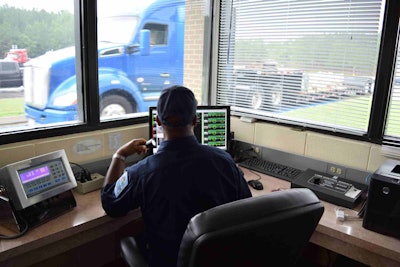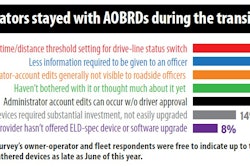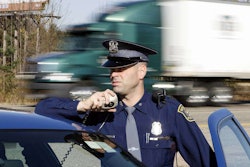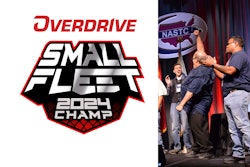
Soon after the electronic logging device mandate took effect Dec. 18, Kris Santoianni and his ELD-exempt unit crossed a scale on Interstate 94 in Lakeland, Minnesota. He was pulled back for an inspection of his 315-inch-wheelbase 1999 Peterbilt 379 that he passed with flying colors.
At the scale counter, he overheard a driver telling the other scale master, “I know it says I was in violation, but I had to find a safe place to park! Do you want me to sleep in the center lane?! The truck stops were full! These computers have no idea what is going on! This is ridiculous!”
“E-logs will cure everything, right?” quips Santoianni, who’s leased to Nelson Truck Lines of Manitowoc, Wisconsin. His sarcastic refrain is common among truckers and, believe it or not, some in law enforcement.
The sentiment was echoed in a meme shared by an Indiana enforcement representative ahead of the mandate’s deadline — a picture of a broken pencil and the text “E-logs would have prevented this” that was featured in the December Overdrive. The trooper’s accompanying sentiment: Hours of service “should be re-evaluated and the ELDs should be used as a bad boy item for carriers that have been found to need help with compliance issues!”
Yet there’s no indication of that change or others coming. Instead, situations such as the one Santoianni witnessed will continue to bedevil truckers and law enforcement getting acquainted with the new reality. In the mandate’s first weeks, the Owner-Operator Independent Drivers Association heard of similar occurrences, says association representative Norita Taylor.
Rules are rules, says Collin Mooney, executive director of the Commercial Vehicle Safety Alliance. Regarding the wiggle room for hours that drivers had enjoyed with paper logs, there is no tweaking of the hours of service in the cards that would restore that unofficial flexibility, he says.
“The ELD rule is highlighting those hours of service rules,” Mooney says. “Drivers and companies have been able to stretch them” on paper in some cases. “ELDs take away that whole practice. That’s where people have the angst” they’re experiencing, he believes. “It does require a little bit more planning” in terms of parking preparation and load and unload timing. “The rule is intended to level the playing field between those who operate within the rules and those who have been extending the rules.”
Yet what advice the federal government and some state officials have given for circumstances such as those in Santoianni’s anecdote – log it like it happened, annotate the log to describe the circumstances, and hope for leniency if it’s questioned – is inadequate to address drivers’ appropriate concerns. Hours-compliance records, as Santoianni and others have pointed out, now are more dependent on the whims of shippers and receivers, port/railyard operators, parking availability, the understanding – or not so understanding – nature of individual inspectors and so much more. While the anti-coercion rule gives drivers an avenue to blow the whistle on shippers, brokers and carriers that would threaten economic harm for their refusal to violate a regulation, otherwise nothing has changed about hours of service.
Minnesota is among many states leaving it up to the officer’s discretion whether to write a ticket for not having an ELD in a truck covered under the mandate. “We all realize this is a monumental change for the CMV industry and that people have waited until the last minute in hopes that something would have changed,” says Capt. Jon Olsen. “Given that, I don’t anticipate you will see inspectors from Minnesota scratching out criminal citations to drivers for failing to comply with the ELD mandate. Conversely, if a driver is stopped in February or March and has no ELD as required, has some falsification issues, etc., I can certainly see and support one of our inspectors giving a criminal citation to the driver for failing to comply with the ELD requirement.”
Georgia State Police Capt. Jeremy Vickery says his state is among those that will not be issuing citations for ELD noncompliance in the early going — prior to the April 1 date when it becomes an out-of-service violation. That’s also when points for such violations begin contributing to carriers’ Compliance, Safety, Accountability scores in the hours category.
Kansas also is among such states. Capt. Chris Turner of the state Highway Patrol says the Federal Motor Carrier Safety Administration didn’t put out the violation code for ELD-related violations in the central enforcement system until a week ahead of the compliance date. “We won’t even really be writing the warning” or documenting the violation in inspection reports “until a few weeks from now,” he said as the mandate was going into effect. “There’s going to be a learning curve, and I think most states are trying to err on the side of caution.”
Vickery, however, emphasizes the opposite viewpoint. It causes the most consternation among highway haulers and was well-illustrated by the driver that Santoianni overhead in Minnesota: “If there is an hours of service violation, our officers will take appropriate enforcement action.”
The hours of service remain what they are, and the situation in Santoianni’s anecdote is something every driver pondering a switch to e-logs has worried about — the inability to find a suitable parking space or other unforeseen circumstance forcing a violation to be recorded by the e-log, something then to be cherry-picked down the line by an officer.
Santoianni elaborated on the overheard driver’s situation. Though he can’t swear it, he suspects the driver walked out of the exchange with a ticket. “His ELD was in order, but it was a heated conversation” over the hours violation, Santoianni says. “And it seemed like [the violation] happened a couple days back.” He again paraphrases the driver: “I went through three truck stops, and there was no parking — I had to find a safe parking spot.”
And the inspector: “It still says you’re in violation. It says right here you’re in violation.”
When it comes to such situations, Santoianni says, “there has to be a common-sense gray area — what are you supposed to do?” The heated nature of the conversation probably didn’t help matters, he believes.
FMCSA representatives have more or less expressed the same kinds of sentiment in their encouragement of state partners to take a gray-area leniency approach, yet the law is the law, and it all fails to account for the emotions generated by such encounters on both enforcement and truckers’ sides. “Thank god I didn’t have that guy,” Santoianni says of the driver’s inspector.
Guidance, perhaps, on greater hours leeway for special circumstances that exists could be the answer, though there is also a sense among some watchers and owner-operators that more clear-cut definitions could present more problems than they solve in the end, leaving even less room for that common sense many see as not so common anymore.
Lt. Thomas Fitzgerald of the state of Massachusetts’ truck-enforcement unit held “hope” for common sense to prevail at roadside. “There is going to be a learning curve for drivers and officers,” he says.
As for Santoianni, he takes special affront to this aspect of mandated ELDs. “Drivers go through different states every day — how can you keep [enforcement] uniform?” he asks. “If it’s not, then that puts the stress on the driver” wondering whether the hours violation his ELD recorded days ago while he was looking for parking is going to net him a citation down the line.
“You go to the truck stops, and they’re jam-packed after 5 o’clock at night,” Santoianni says. “It’s bad enough that common sense isn’t so common today, but this is making it all that much worse. … Guys like us who’ve been trucking a long time and still take pride in what we do — we feel like they’re trying to chase us out.”
Rather than deal with such headaches, a lot of his friends in trucking, he adds, have been looking around for local opportunities where logs aren’t an issue — or just going out to find something else to do altogether.
He’s lucky, he says, with the exempt truck and his shipper/receiver customers that are familiar day in and day out, many offering opportunities to park on their premises if timing goes haywire. “A lot of guys don’t have that,” he adds. With the rules the way they are, it feels to them like regulators are “chasing truckers out of trucking to make room for the guys who don’t know any better.”
Owner-operator Rudy Yakym Jr. agrees. Based in the Midwest, he runs a one-ton dually hotshot with a 53-foot step deck hauling travel trailers and other lighter commodities. He’s experienced no small amount of frustration with the addition of an ELD in recent weeks.
“I missed a drop by 10 minutes, and it cost me an overnight stay on the West Coast,” Yakym says, before he could reach the unload location. He says he’s “had several situations where having the 14 and 10 as rigid as it is” have cost him.
In addition, scheduling pressures as supply chain participants adjust to new enforcement of rigidities have been such that “I’ve found myself driving when I shouldn’t,” Yakym says. “I am frustrated. I think we’re going to lose a lot of drivers.”
None of Wyoming-headquartered small tanker fleet owner-operator Mintu Pandher’s nine late-model Peterbilt 389s were yet outfitted with ELDs, he reported in the early going after the mandate deadline. A few are exempt gliders, but most are not. His drivers run six states around his home base in Laramie, and he said at the time that no tickets (citations) had been written to any as yet for not having an ELD. Pandher, who participated in protests in Washington, D.C., in October, wasn’t sure what he’ll do in the coming weeks.
In the meantime, some measure of soft enforcement is likely to continue in most if not all states, at least through April Fool’s Day. Kentucky, among states saying they’ll delay no-ELD ticket writing through that date, showed some evidence of a little tough love on offer as “encouragement” in the interim.
At the scale house counter on I-65 near Franklin on the day the mandate went into effect, an inspector could be heard asking a driver if he was using an ELD — he wasn’t. The reality: He hadn’t bothered to plug it in yet, given expectation of soft enforcement and no actual training from his fleet. As he exited to get into his truck and pull it into the scale’s inspection barn, the officer noted he had better plug the ELD in before he pulled the truck around.
Shaking his head later out by his truck and powering up a tablet he’d been given to pair with the ECM’s plug-in device, the driver, who declined to be named for this report, said simply, “I’d better roll down there. I think he’s mad at me.”











